Home » Articles » Oil & Gas » Oil and Natural Gas Resources of the Arctic
Oil and Natural Gas Resources of the Arctic
Article by: Hobart M. King, PhD, RPG
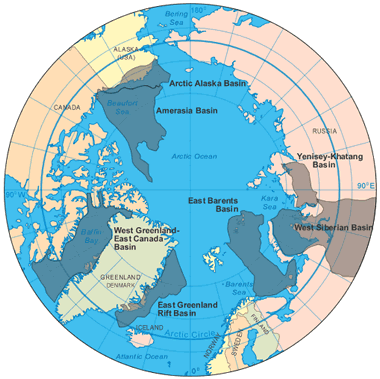
Arctic Oil and Natural Gas Provinces Map: The United States Geological Survey estimates that over 87% of the Arctic's oil and natural gas resource (about 360 billion barrels oil equivalent) is located in seven Arctic basin provinces: Amerasian Basin, Arctic Alaska Basin, East Barents Basin, East Greenland Rift Basin, West Greenland-East Canada Basin, West Siberian Basin, and the Yenisey-Khatanga Basin. Map by Geology.com and MapResources. [1] [2]

Ice road to an oil rig: Access to drilling sites on land in the Arctic can require building, rebuilding and maintaining many miles of ice roads. There is no other way to get heavy equipment into these sites, and road access can be limited to just a few weeks or few months each year. Bureau of Land Management photo.
An Enormous Undiscovered Resource
The area above the Arctic Circle is underlain by sedimentary basins and continental shelves that hold enormous oil and natural gas resources. Most of this area is poorly explored for oil and natural gas; however, the United States Geological Survey estimates that the Arctic contains approximately 13 percent of the world's undiscovered conventional oil resources and about 30 percent of its undiscovered conventional natural gas resources.
This makes the Arctic an incredibly rich area. It is about the same geographic size as the African continent - about 6% of Earth's surface area - yet it holds an estimated 22 percent of Earth's oil and natural gas resource. [3]
Most of the exploration in the Arctic to-date has taken place on land. This work has resulted in the Prudhoe Bay Oil Field in Alaska, the Tazovskoye Field in Russia and hundreds of smaller fields, many of which are on Alaska's North Slope. Land accounts for about 1/3 of the Arctic's area and is thought to hold about 16% of the Arctic's remaining undiscovered oil and gas resource. [4]
About 1/3 of the Arctic area is continental shelves which have been very lightly explored. The Arctic continental shelves are the largest geographic area on Earth with enormous probable resources that remains virtually unexplored. The remaining 1/3 of the Arctic is deep ocean waters over 500 meters deep, and this area is unexplored. [4]
| Petroleum Province | Crude Oil (billion barrels) | Natural Gas (trillion cubic feet) | Natural Gas Liquids (billion barrels) | Total (oil equivalent in billions of barrels) |
| West Siberian Basin | 3.66 | 651.50 | 20.33 | 132.57 |
| Arctic Alaska | 29.96 | 221.40 | 5.90 | 72.77 |
| East Barents Basin | 7.41 | 317.56 | 1.42 | 61.76 |
| East Greenland Rift Basin | 8.90 | 86.18 | 8.12 | 31.39 |
| Yenisey-Khatanga Basin | 5.58 | 99.96 | 2.68 | 24.92 |
| Amerasian Basin | 9.72 | 56.89 | 0.54 | 19.75 |
| West Greenland-East Canada | 7.27 | 51.82 | 1.15 | 17.06 |
| Table 1: Arctic area mean estimated undiscovered technically recoverable, conventional oil and natural gas resources for the seven largest Arctic basin provinces. These seven provinces account for about 360 billion barrels oil equivalent or over 87% of the total undiscovered Arctic area resource. [4] | ||||
Arctic Oil and Natural Gas Resource Basins
The United States Geological Survey has estimated the undiscovered technically recoverable conventional oil, natural gas, and natural gas liquids resources north of the Arctic Circle to be approximately 412 billion barrels oil equivalent. Their estimates place over 87% of the resource (360 billion barrels oil equivalent) into seven Arctic basin provinces: Amerasian Basin, Arctic Alaska Basin, East Barents Basin, East Greenland Rift Basin, West Greenland-East Canada Basin, West Siberian Basin, and the Yenisey-Khatanga Basin.
These seven Arctic basin provinces are shown on the map at the top of this page, and their resource distributions are presented in Table 1. [4] It is clear from this data that most of the Arctic area resource is natural gas and that the Asian side of the Arctic area has the highest proportion of natural gas and natural gas liquids.
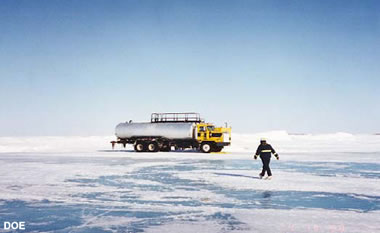
Ice road water truck: Water truck used to build and maintain the ice roads. Department of Energy photo.

Gas hydrate well: Ignik Sikumi #1 gas hydrate well on the Alaska North Slope. The Arctic has an extensive gas hydrate resource that was not included in the USGS undiscovered oil and gas assessment because gas hydrate is an unconventional resource. Department of Energy photo.
Jurisdiction of the Arctic
Portions of eight countries are situated above the Arctic Circle: Canada, Denmark (via Greenland), Finland, Iceland, Norway, Russia, Sweden, and the United States. Six of them border the Arctic Ocean and thus have a jurisdictional claim to portions of the Arctic seafloor: Canada, Denmark (via Greenland), Iceland, Norway, Russia, and the United States.
Their claims to oil and gas beneath the Arctic Ocean seafloor have historically been determined by unilateral decrees; however, the Law of the Sea Convention provides each country an exclusive economic zone extending 200 miles out from its shoreline. Under certain conditions the exclusive economic zone can be extended out to 350 miles, if a nation can demonstrate that its continental margin extends more than 200 miles beyond its shore. Russia, Canada, and the United States are currently working to define the extent of their continental margin.
This provision has led to some overlapping territorial disputes and disagreements over how the edge of the continental margin is defined and mapped. For example, Russia claims that their continental margin follows the Lomonosov Ridge all the way to the North Pole. In another, both the United States and Canada claim a portion of the Beaufort Sea in an area that is thought to contain significant oil and natural gas resources.

Orion Oil Pool Map: Map of the Orion Oil Pool in the Prudhoe Bay Unit. Horizontal well drilling technology has been used extensively to develop this pool. There are currently only five producing wells located on V-Pad, but these five original well bores are fed by 15 additional lateral well branches.

Orion Oil Pool permafrost: Permafrost area above the Orion Oil Pool. Multiple wells with horizontal branches allows oil to be drained from a very large area from a single drill pad.
Challenges of Oil & Gas Exploration in the Arctic
The Arctic is a cold, remote, dark, dangerous and expensive place to explore for oil and natural gas. The Arctic's vast oil resource and the high price of oil are what currently attract attention to the Arctic area.
Where ice-free water is available, oil can be produced from a well, placed on a ship and transported to refineries. It can also be transported by pipeline; however, construction of pipelines in the Arctic are projects of enormous difficulty and scale.
Natural gas is much more difficult to transport to market. It has a much lower energy density and must be supercooled to a liquid for movement by sea. This requires a large, complex and expensive facility that takes several years to design, permit and build. Pipeline construction for natural gas encounters the same expenses and problems as those required to transport oil.
Offshore exploration in the Arctic currently targets oil instead of natural gas. The relative ease of transport is what causes companies to favor oil.
Because of these difficulties and expenses, bringing wells into production in the Arctic requires a very large oil or gas field. The large field is necessary to support the infrastructure required to drill the wells and transport products to market. However, once an initial infrastructure is in place, smaller fields can be developed if the existing infrastructure has the capacity to support them.
| Arctic Oil and Natural Gas References |
|
[1] Arctic Oil and Natural Gas Resources: United States Energy Information Administration, www.eia.gov. December 2011.
[2] Global Crustal and Lithospheric Structure Atlas: EarthByte: Linking Observations to kinematic and dynamic models, School of Geosciences, The University of Sydney, Australia. Last accessed September 2016. [3] Arctic Oil and Natural Gas Potential: Philip Budzik, U.S. Energy Information Administration, Office of Integrated Analysis and Forecasting, Oil and Gas Division. October 2009. [4] Circum-Arctic Resource Appraisal: Estimates of Undiscovered Oil and Gas North of the Arctic Circle: Kenneth J. Bird and others, United States Geological Survey, Fact Sheet 2008-3049. July 2008. [5] The United Nations Convention on the Law of the Sea: United Nations Division for Ocean Affairs and the Law of the Sea. December 1982. [6] Arctic Ocean Seafloor Features Map: A map showing the seafloor features of the Arctic Ocean including major ridges, basins, shelves and rifts, Geology.com, April 2012. |
Why Arctic Exploration is so Expensive
A short list of reasons why oil and gas exploration in the Arctic is so expensive... [3]
- Harsh winter weather requires that the equipment be specially designed to withstand the frigid temperatures.
- On Arctic lands, poor soil conditions can require additional site preparation to prevent equipment and structures from sinking.
- The marshy Arctic tundra can also preclude exploration activities during the warm months of the year.
- In Arctic seas, the icepack can damage offshore facilities, while also hindering the shipment of personnel, materials, equipment, and oil for long time periods.
- Long supply lines from the world's manufacturing centers require equipment redundancy and a larger inventory of spare parts to ensure reliability.
- Limited transportation access and long supply lines reduce the transportation options and increase transportation costs.
- Higher wages and salaries are required to induce personnel to work in the isolated and inhospitable Arctic.
These difficulties make the cost of oil exploration and production in the Arctic to be nearly double the cost of other areas. However, the enormous resource has attracted a lot of oil and gas activity. This will continue into the future. Interest in the Arctic will only increase as oil and natural gas fields in other areas are depleted and the cost of oil and gas rises.
| More Oil |
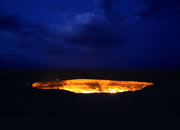 |
The Doorway to Hell |
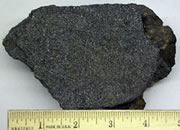 |
Oil Sands |
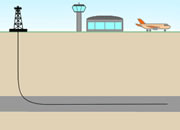 |
Horizontal Drilling |
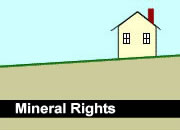 |
Oil and Gas Rights |
 |
Shale Gas Resources |
 |
Gifts That Rock |
 |
What is LNG? |
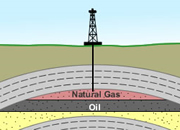 |
Natural Gas Investing |

Find Other Topics on Geology.com:

|

| ||

|

| ||

|

| ||

|

|
